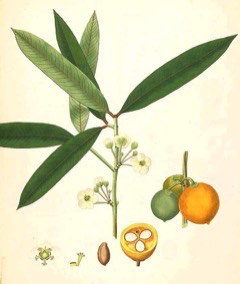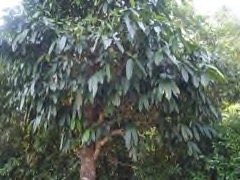 |
|
edibleplants.org |
 |
| wikimedia.org Dinesh Valke |
Translate this page:
Summary
Physical Characteristics

 Garcinia xanthochymus is an evergreen Tree growing to 12 m (39ft) by 12 m (39ft) at a slow rate.
Garcinia xanthochymus is an evergreen Tree growing to 12 m (39ft) by 12 m (39ft) at a slow rate.
See above for USDA hardiness. It is hardy to UK zone 10.
Suitable for: light (sandy), medium (loamy) and heavy (clay) soils, prefers well-drained soil and can grow in nutritionally poor soil. Suitable pH: mildly acid, neutral and basic (mildly alkaline) soils and can grow in very acid and very alkaline soils.
It can grow in semi-shade (light woodland) or no shade. It prefers moist soil.
UK Hardiness Map
US Hardiness Map
Synonyms
Garcinia pictoria (Roxb.) Engl. Garcinia tinctoria (DC.) W. Wight Xanthochymus pictorius Roxb. Xanthochymus tinctorius DC.
Plant Habitats
Edible Uses
Edible Parts: Fruit
Edible Uses:
Fruit - raw or cooked[301 ]. The fruit is edible but is rather sour[266 ]. Aromatic[335 ]. A pleasant, acid taste, it is mainly used as a breakfast fruit[301 , 418 ]. It can be eaten fresh, used in sherbets, jams, curries and vinegars, or as a flavouring in other foods[335 , 418 ]. The fruit is a rich source of citric acid[335 ]. The mature berry is yellow, globose or ovoid, sometimes oblique, 3 - 5 cm in diameter[266 ].
References More on Edible Uses
Medicinal Uses
Plants For A Future can not take any responsibility for any adverse effects from the use of plants. Always seek advice from a professional before using a plant medicinally.
None known
References More on Medicinal Uses
The Bookshop: Edible Plant Books
Our Latest books on Perennial Plants For Food Forests and Permaculture Gardens in paperback or digital formats.

Edible Tropical Plants
Food Forest Plants for Hotter Conditions: 250+ Plants For Tropical Food Forests & Permaculture Gardens.
More

Edible Temperate Plants
Plants for Your Food Forest: 500 Plants for Temperate Food Forests & Permaculture Gardens.
More

More Books
PFAF have eight books available in paperback and digital formats. Browse the shop for more information.
Shop Now
Other Uses
The seeds yield up to 17% oil[266 ]. The juice of the fruit is used as a dye[377 ]. Gamboge, a gum-resin obtained from the plant, is used as a yellow dye, as an illuminant and in varnishes, water colours etc[46 ]. The dye is often used for dyeing the robes of Buddhist priests[317 ]. Young plants are used as rootstocks for the mangosteen, Garcinia mangostana[317 ].
Special Uses
Carbon Farming
References More on Other Uses
Cultivation details
Industrial Crop: Hydrocarbon Management: Standard Regional Crop
A plant of the hot, humid tropics, where it is found at elevations up to 1,000 metres[335 , 418 ]. It grows best in areas where annual daytime temperatures are within the range 22 - 28°c, but can tolerate 16 - 36°c[418 ]. Plants are tolerant of occasional light frosts[335 ]. It prefers a mean annual rainfall in the range 1,500 - 2,000mm, but tolerates 1,200 - 2,500mm[418 ]. Tolerant of shade[335 ]. Succeeds in most well-drained soils including poor soils and soils with a high pH[335 , 418 ]. Prefers a pH in the range 6 - 7.5, tolerating 5.5 - 8[418 ]. Seedling trees can commence fruit production when 7 - 8 years old[335 ]. Flowering usually occurs after a spell of pronounced dry weather and can occur twice a year[418 ].
Carbon Farming
-
Industrial Crop: Hydrocarbon
Materials, chemicals and energy include bioplastics, rubber, biomass products gasoline, jet fuel, diesel, butane, propane, biogas. Plants are usually resprouting plants and saps.
-
Management: Standard
Plants grow to their standard height. Harvest fruit, seeds, or other products. Non-Destructive management systems.
-
Regional Crop
These crops have been domesticated and cultivated regionally but have not been adopted elsewhere and are typically not traded globally, Examples in this broad category include perennial cottons and many nuts and staple fruits.
References Carbon Farming Information and Carbon Sequestration Information
Temperature Converter
Type a value in the Celsius field to convert the value to Fahrenheit:
Fahrenheit:
The PFAF Bookshop
Plants For A Future have a number of books available in paperback and digital form. Book titles include Edible Plants, Edible Perennials, Edible Trees,Edible Shrubs, Woodland Gardening, and Temperate Food Forest Plants. Our new book is Food Forest Plants For Hotter Conditions (Tropical and Sub-Tropical).
Shop Now
Plant Propagation
Seed - we have no specific information on this species, but the seed of most members of the genus can be slow to germinate, even if sown fresh, often taking 6 months or more[K ].
Other Names
If available other names are mentioned here
Asam kandis, Chakhasa, Cochin-goraka, Da ye teng huang, Dampal, Daungyan, Dawyan-ban, Dephal, Dieng-soh-rynsan, Dongbei, False mangosteen, Gavei, Guomanda, Hmandaw, Hong Phap, Jevra memadie, Mada-luang, Mada, Madaw, Mysore gamboge, Pohon manggis asam, Tamala, Tempwr, Tepor tenga, Thesampreng, Tinctoria, Tuai-ha-bet, Yellow mangosteen
Native Range
TEMPERATE ASIA: China (Guangxi Zhuangzu Zizhiqu (southwest), Yunnan Sheng) TROPICAL ASIA: Bangladesh, Bhutan, India (Sikkim, Andhra Pradesh, Assam, Kerala, Maharashtra, Meghalaya, Odisha, Tamil Nadu, Tripura, Karnataka, Goa), Nepal, India (Andaman and Nicobar Islands), Cambodia, Laos, Myanmar, Thailand, Vietnam, Malaysia
Weed Potential
Right plant wrong place. We are currently updating this section.
Please note that a plant may be invasive in one area but may not in your area so it's worth checking.
None Known
Conservation Status
IUCN Red List of Threatened Plants Status : This taxon has not yet been assessed

Growth: S = slow M = medium F = fast. Soil: L = light (sandy) M = medium H = heavy (clay). pH: A = acid N = neutral B = basic (alkaline). Shade: F = full shade S = semi-shade N = no shade. Moisture: D = dry M = Moist We = wet Wa = water.
Now available:
Food Forest Plants for Mediterranean Conditions
350+ Perennial Plants For Mediterranean and Drier Food Forests and Permaculture Gardens.
[Paperback and eBook]
This is the third in Plants For A Future's series of plant guides for food forests tailored to
specific climate zones. Following volumes on temperate and tropical ecosystems, this book focuses
on species suited to Mediterranean conditions—regions with hot, dry summers and cool, wet winters,
often facing the added challenge of climate change.
Read More
Expert comment
Author
Hook.f.
Botanical References
Links / References
For a list of references used on this page please go here
A special thanks to Ken Fern for some of the information used on this page.
Readers comment
| Add a comment |
|
If you have important information about this plant that may help other users please add a comment or link below. Only comments or links that are felt to be directly relevant to a plant will be included. If you think a comment/link or information contained on this page is inaccurate or misleading we would welcome your feedback at [email protected]. If you have questions about a plant please use the Forum on this website as we do not have the resources to answer questions ourselves.
* Please note: the comments by website users are not necessarily those held by PFAF and may give misleading or inaccurate information.
To leave a comment please Register or login here All comments need to be approved so will not appear immediately.
|
Subject : Garcinia xanthochymus
|
|
|
|